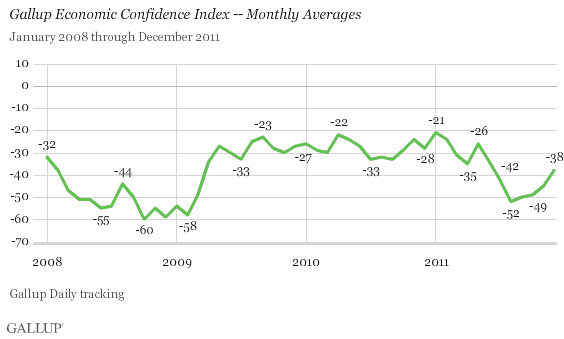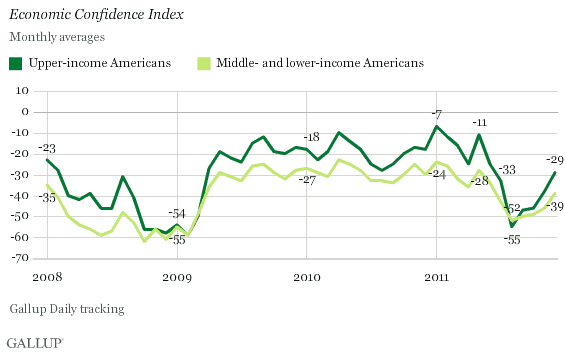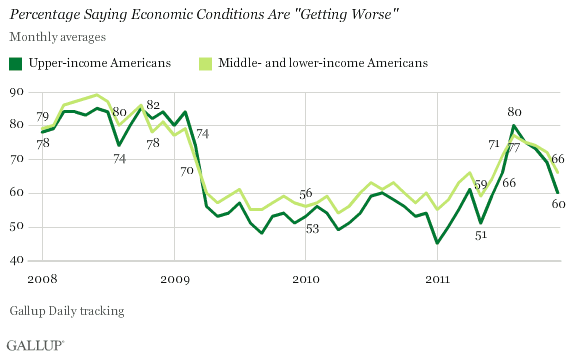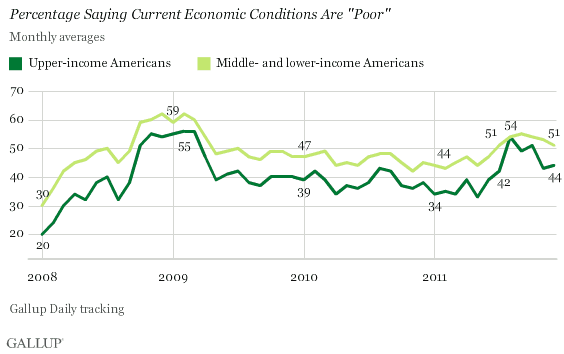PRINCETON, NJ -- Americans' economic confidence continued to improve in December with Gallup's Economic Confidence Index reaching -38 as consumers expressed more optimism than at any time since June. However, consumers remain less confident than they were earlier in 2011 and in December of the prior two years.

U.S. economic confidence plummeted in August as Washington battled over extension of the federal debt ceiling with Gallup's Economic Confidence Index reaching -52. At that point, consumer confidence was at its worst since February 2009. Since then, the Index has improved steadily but has not recovered to earlier 2011 levels.
Weekly economic confidence improved throughout December, reaching -34 during the week ending Jan. 1, 2012. This is its best weekly level since the week ending July 10. Still, economic confidence remains worse than the -26 of that same week one year ago.

Upper-Income Americans More Optimistic
Upper-income Americans' Economic Confidence Index score improved to -29 in December from -38 in November and -55 in August. The Index also improved to -39 among middle- and lower-income Americans from -46 in November and -52 in August. While Economic Confidence Index scores have improved sharply for both income groups since August, the scores of upper-income Americans have shown relatively greater improvement. Still, confidence in both groups remains below levels measured in December of 2010 and 2009.

Gallup's Economic Confidence Index combines Americans' views on economic conditions now and their expectations for the economy in the future. Upper-income Americans' expectations for the future improved in December, with 60% saying the economy is "getting worse" -- sharply better than the 69% in November and the 80% in August.

Upper-income Americans tend to be more optimistic about the future of the economy than those with lower incomes. This situation was reversed in August -- as was the case in late 2008 and early 2009, however upper-income Americans are again now less pessimistic than middle- and lower-income Americans.
Middle- and lower-income Americans' outlook for the economy has seen similar -- albeit more modest -- improvement during recent months, with 66% saying the economy is "getting worse." This is better than the 72% in November and 77% in August.
Forty-four percent of upper-income Americans rate current economic conditions "poor." This is essentially the same as in November, but improved from the 54% of August, which was the highest level since March 2009.

Fifty-one percent of middle- and lower-income Americans also rate current economic conditions "poor" -- not much different than the 53% of November and essentially the same as the previous three months. These Americans' "poor" ratings remain among the highest for this group since April 2009.
Americans' Economic Expectations Improving
Americans' economic confidence has shown steady improvement since the lows seen during the August debt ceiling debate. Increased confidence appears to be largely driven by a sharp improvement in consumers' future expectations for the U.S. economy as opposed to a significant change in current economic conditions.
In part, this improvement may reflect the recent government reports that the U.S. unemployment rate declined to 8.6% in November and the recent declines in jobless claims, even taking the last weekly report of an increase into account. Gas prices have been decreasing. Overall, the economy seems to be improving modestly.
Upper-income Americans' improved confidence about the future course of the economy is a particularly positive sign. Despite all the trials and tribulations this year, Wall Street ended the year no worse off than a year ago. In spite of all the talk about increased taxes for the upper-income, nothing has changed in 2011. Further, higher taxes seem unlikely any time soon, given that 2012 is a presidential election year.
At the same time, it appears Americans have not been discouraged by such things as the recent political confrontation in Washington concerning the payroll tax cut extension or the need for the president to request another increase the debt ceiling in coming weeks. The same is true for the continuing financial challenges in Europe and the economic slowdown in China.
Despite its improving trend, economic confidence has yet to recover to levels seen in December of 2009 and 2010. The question going forward is whether the current trend of increasing confidence will continue, or instead, fall by the wayside as it has in the past.
Gallup.com reports results from these indexes in daily, weekly, and monthly averages and in Gallup.com stories. Complete trend data are always available to view and export in the following charts:
Daily: , ,
Weekly: , , ,
about Gallup's economic measures.
our economic release schedule.
Survey Methods
Results are based on telephone interviews conducted on a monthly basis from January 2008 to December 2011. Each month, 优蜜传媒on its 优蜜传媒Daily Tracking survey conducts interviews with a random sample of approximately 15,000 adults, aged 18 and older, living in all 50 U.S. states and the District of Columbia. For results based on the total sample of national adults, one can say with 95% confidence that the maximum margin of sampling error is 卤3 percentage points.
During the period of Dec. 1-28, 2011, 优蜜传媒conducted interviews with a random sample of 12,924 adults, aged 18 and older, living in all 50 U.S. states and the District of Columbia. For results based on the total sample of national adults, one can say with 95% confidence that the maximum margin of sampling error is 卤3 percentage points.
Results are based on telephone interviews conducted as part of 优蜜传媒Daily tracking during the period of Monday to Sunday with random weekly samples averaging more than 3,000 adults, aged 18 and older, living in all 50 U.S. states and the District of Columbia, selected using random-digit-dial sampling.
During the week ended Dec. 29, 2011, 优蜜传媒conducted 2,470 results interviews with national adults as part of 优蜜传媒Daily tracking. For samples of this size, one can say with 95% confidence that the maximum margin of sampling error is 卤3 percentage point.
Interviews are conducted with respondents on landline telephones and cellular phones, with interviews conducted in Spanish for respondents who are primarily Spanish-speaking. Each sample includes a minimum quota of 400 cell phone respondents and 600 landline respondents per 1,000 national adults, with additional minimum quotas among landline respondents for gender within region. Landline telephone numbers are chosen at random among listed telephone numbers. Cell phones numbers are selected using random digit dial methods. Landline respondents are chosen at random within each household on the basis of which member had the most recent birthday.
Samples are weighted by gender, age, race, Hispanic ethnicity, education, region, adults in the household, and phone status (cell phone-only/landline only/both, cell phone mostly, and having an unlisted landline number). Demographic weighting targets are based on the March 2010 Current Population Survey figures for the aged 18 and older non-institutionalized population living in U.S. telephone households. All reported margins of sampling error include the computed design effects for weighting and sample design.
In addition to sampling error, question wording and practical difficulties in conducting surveys can introduce error or bias into the findings of public opinion polls.
For more details on Gallup's polling methodology, visit .
